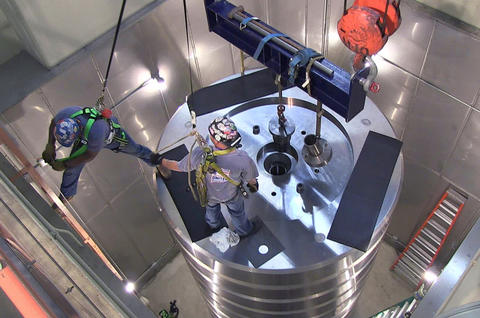Fundamental Measurement, Quantum Science and Measurement Dissemination

At the heart of NIST’s mission is the dissemination of the fundamental units of measurement (the International System of Units, or SI).
NIST determines the definitive methods for nearly every kind of measurement employed in commerce and research, provides NIST-traceable calibrations, and disseminates standards and best practices throughout the nation.
Staying ahead of the increasingly challenging demands of U.S. industry requires that NIST push the frontiers of measurement science by devising new tools and techniques—especially at the quantum scale where the rules of classical physics do not apply.
Through balanced and coordinated programs, NIST leads the world in disseminating the fundamental units of measurement. This leadership in metrology advancement directly impacts NIST’s relevance and leadership in measurement services.
Budget Request
NIST requests a total of $127.0 million to support core measurement science programs advancing the precision, accuracy and comparability of the measurements that underpin the U.S. economy and innovation ecosystem. The FY 2019 request is a net decrease of $49.0 million from FY 2018 levels. The proposed reductions will allow NIST to consolidate and focus on narrower core SI measurement programs while meeting budget levels. NIST will focus on basic research while reducing funding for efforts applying some of its breakthroughs into new measurement applications.
FY 2018 Annualized CR: $176.0 M
- Lab Programs: $129.8 M
- Corporate Services: $4.3 M
- SCO/SPO: $42.0 M
FY 2019 Request: $127.0 million (-27.8%)
- Lab Programs: $103.2 M
- Corporate Services: $2.3 M
- SCO/SPO: $21.5 M

Illustrative program reductions in FY 2019
- -$6.3 million supporting fundamental measurement dissemination, including the shutdown of NIST radio stations in Colorado and Hawaii
- -$3.5 million for Lab to Market, which seeks to accelerate technology transfer from federal laboratories
- -$6.6 million in environmental measurements projects across NIST laboratories, including work measuring the impact of aerosols on pollution and climate change, and gas reference materials used by industry to reduce costs of complying with regulations
- -$5.8 million eliminating the NIST Greenhouse Gas (GHG) Measurements program, including Urban Dome research grants to advance the direct measurement of GHG emissions on the scale of cities or regions.
- -$6.7 million in forensic science, reducing the program size to $7.3 million by prioritizing measurement science in the NIST labs and eliminating program management functions and external grants for the Organization of Scientific Area Committees for Forensic Science and the Forensic Science Center of Excellence
- -$4.1 million in R&D targeting application of NIST quantum breakthroughs to applied measurement needs, including temperature and atmospheric gas metrology
Program Highlights

NIST has a broad portfolio of fundamental measurement science and dissemination capabilities. With its strong quantum science expertise, NIST supports the nation’s measurement needs, ensuring safe health care, confidence in retail transactions, and integrity in forensic science, while spurring discovery. NIST will continue to ensure U.S. leadership in international metrology and support the measurement needs for domestic innovation and commerce. For example:
- Through NIST, the U.S. leads an international effort to change the definition of the kilogram from a physical object housed in Paris, France, to a value based on the fundamental physical principles of the universe. To do this, NIST built an exquisitely accurate weighing machine to measure mass using electrical currents and mechanical forces.
- Through its calibration services, NIST provides U.S. industry with measurements needed to design new products and manufacturing processes. For example, calibrations made using NIST’s Million Pound Deadweight Machine help aerospace engineers know whether their materials and designs will withstand the massive forces that occur during takeoff and during flight.
- NIST-developed devices delivering measurement certainty and reliability without needing recalibration have transformed electrical measurements for U.S. industry. The ongoing modernization of the U.S. power grid is being supported by the quantum-based accuracy of these electrical measurements.
- State legal metrology laboratories help ensure equity in the marketplace and provide reference standards for calibration services for industry. NIST’s Office of Weights and Measures ensures traceability of state weights and measures standards to the SI, develops procedures for legal metrology tests and inspections, and conducts training for laboratory metrologists and weights and measures officials.
- NIST has built up extraordinary expertise in quantum research as it has pushed measurement science at the boundaries of the possible and continues to make advances in the study and control of quantum systems. For example, a team of scientists at the Joint Quantum Institute, a partnership between NIST and the University of Maryland, have created a quantum simulator mimicking magnetism on an atomic scale that is better than previous demonstrations and paves the way for quantum simulators that model systems even today’s supercomputers cannot.
- NIST scientists have developed the most sensitive and accurate measurement tools in the world—from the world’s most stable clock for measuring frequency to sensors that can detect single photons. These tools enable research into the fundamental physics of the universe. A recent experiment using NIST’s photon detectors proved the existence of quantum entanglement.

